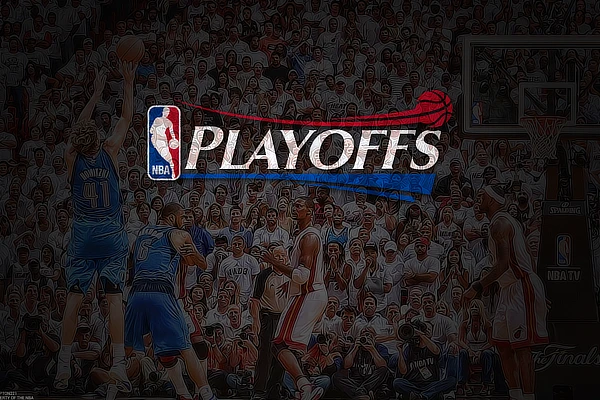
The NBA Playoffs consists of the best teams within the Western Conference and Eastern Conference during the Regular Season, with the best players during the Regular Season typically being featured in the Playoffs for contributing to the high regular season win total. The Most Valuable Player award describes the “most valuable”, which is typically interchangeable with “best”, player during the regular season as voted by sports media analysts, journalists, and other fans. Some players who have received this accolade in recent years include Joel Embiid, Nikola Jokic, Giannis Antetokounmpo, James Harden, Russell Westbrook, Stephen Curry, Kevin Durant, LeBron James, etc. However, the best player during the regular season does not always translate to having the position as the best playoffs player who carries their team to the championship. In fact, the last player to win the NBA MVP award and championship in the same season was eight years ago with Stephen Curry in 2015 as part of the Golden State Warriors. It has been a long time since a player won NBA Regular Season and Finals MVP which was last LeBron James in 2013 as part of the Miami Heat, which was 10 years ago! There is a clear differentiation between regular season and playoffs performance, and the purpose of this project is to identify the largest playoff “risers”, or players who outperform their regular season performance during the playoffs, or playoff “droppers”, or players who underperform in the playoffs compared to their regular season performance.
The basis to identify “risers” and “droppers” is based on their MVP probability which is based on a logistic regression model. The statistics accounted into the model were points per game, assists per game, rebounds per game, steals per game, blocks per game, individual wins, player efficiency rating, win shares per 48, box plus minus, and value over replacement player. These statistics were applied to players for their regular season and postseason performance, with the sample set being filtered to players who played at least 41 games in the regular season. Logistic regression is utilized because it is suitable for binary response variables. The binary response variable in the model is the mvp variable with 1 being assigned to players who won MVP in their respective season and 0 to everyone else. The model can be used to create a prediction value for each player within each season for their regular season and playoff performance. This prediction value is then converted into probability as each entry is grouped by season, so the probability is that player’s prediction value over the sum of the prediction values in that season. The results are then further filtered to players who had at least 1% chance of winning MVP based on their regular season and playoff stats to prevent any players who “rose” or “dropped” due to small percentages in the first place.
The largest single season playoff “risers” and “droppers” along with the largest average playoff “risers” and “droppers” (based on the seasons where they satisfy the >= 1% criteria with the number of seasons satisfying these criteria included in the table) are shown in the tables below:
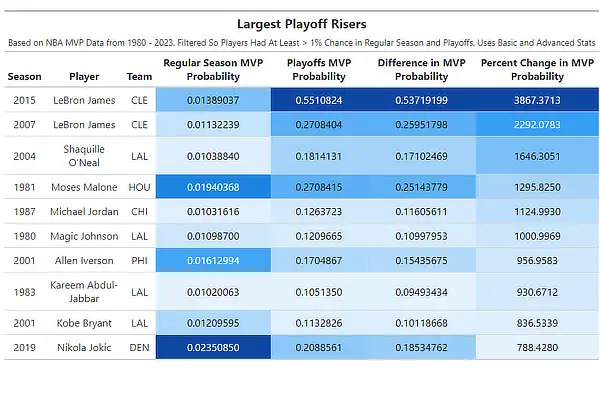
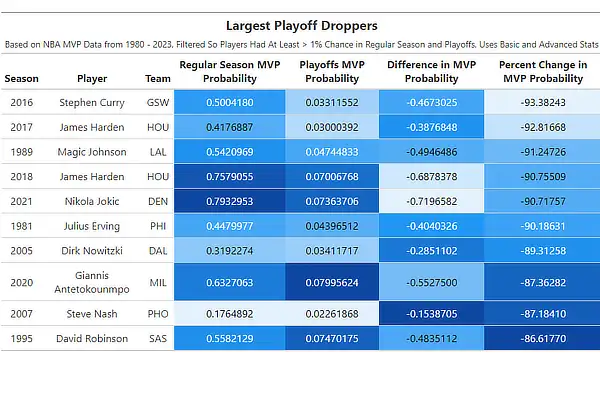
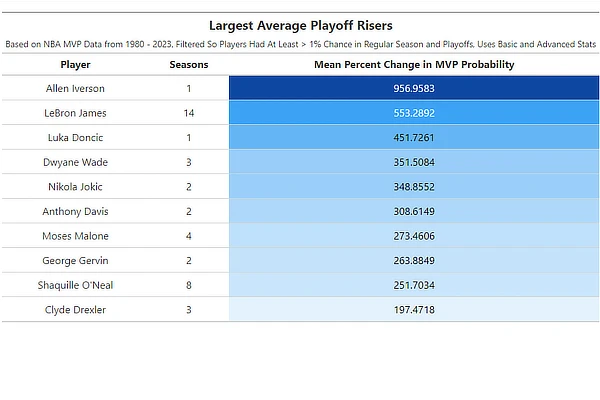
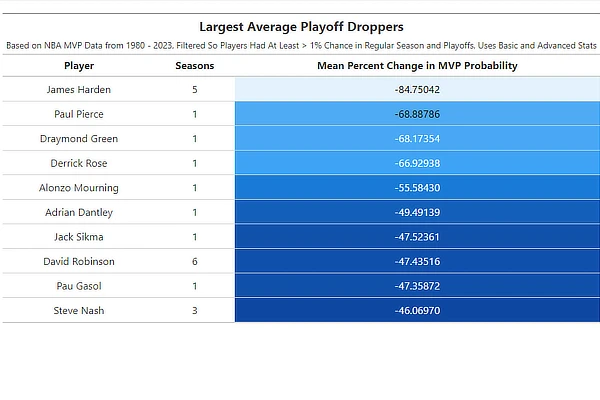
In the tables describing average “risers” and “droppers”, there are many players who have only had 1 season satisfying the >= 1% MVP probability criteria in both regular season and playoffs. This makes the statistics with a larger sample size of seasons quite impressive, such as LeBron James with 14 seasons for playoff rising and James Harden with 5 seasons for playoff dropping. However, the idea of taxing players for being “playoff droppers” is an ignorant criterion considering there are players who naturally have unbelievably great production in the regular season that it is hard to keep up in the playoffs (and it will still be considered dropping even if they perform well in the playoffs, just not to the same level of the regular season).
There are obvious limitations with this project, as statistics in general do not tell the full story regarding a player’s performance. In addition, this does not consider the teams that the player played against in the playoffs as the statistics will be diminished if they play top-tier offenses and defenses during the playoffs. However, it is important to see how players compare in the regular season and playoffs, especially for those who purely consider accolades when evaluating a player as the Most Valuable Player award only applies to the regular season but does not consider playoffs which is arguably more important in its entirety considering the skill level of teams is more uniform and proves resilience against top-tier teams.
The R code for this project can be viewed here.
About the Author

Amrit Vignesh is a high school senior at Seminole High School in Sanford, FL. He is interested in pursuing a career in either nanomaterials research or sports analytics.
